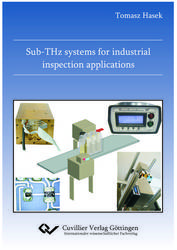| Departments | |
|---|---|
| Book Series (96) |
1371
|
| Nachhaltigkeit |
3
|
| Gesundheitswesen |
1
|
| Humanities |
2359
|
| Natural Sciences |
5400
|
| Engineering |
1785
|
| Engineering | 291 |
| Mechanical and process engineering | 861 |
| Electrical engineering | 682 |
| Mining and metallurgy | 30 |
| Architecture and civil engineering | 75 |
| Common |
97
|
|
Leitlinien Unfallchirurgie
5. Auflage bestellen |
|
Advanced Search
Sub-THz systems for industrial inspection applications (English shop)
Tomasz Hasek (Author)The aim of the work is to investigate new application areas for sub-terahertz (sub-THz) imaging systems. Another important task is to develop a millimeter wave scanner for application in industrial plants.
Based on the setup employing a commercial vector network analyser equipped with a lens system, the feasibility for materials scanning is explored. As a result, a great potential for quality checking with microwaves is discovered. One of the application fields is the food industry. In particular, the use of millimeter wave systems for the detection of foreign objects and quality control is evaluated. The employment of screening systems is also of particular interest in the plastics industry. In the thesis it is proven that microwave imagers are well suited to the quality assessment of plastic welds and polymers. Typical problems appearing during the manufacturing of plastics including delaminations or the presence of inclusions can be detected. For plastics containing additives, a particle distribution map can be obtained. Since the millimeter waves are attenuated by water, another application of this part of the electromagnetic spectrum is the control of rehydration process in plants. Finally, the employment of microwave systems for security scanning is presented, however it is limited to the recognition of relatively high volume items.
Based on promising results obtained with the network analyser, a 35 GHz system employing commercially available microwave components is constructed. Together with the developed optics, electronics hardware and software, a fully stand-alone screening system for the completeness evaluation in the food industry is built. It is shown that the inspector, which was successfully tested in industrial plants, is capable of detecting a missing or an empty bottle in a drink container. For further integration and cost reduction, another standalone screening system operating at the frequency of 38 GHz is developed. The Gigahertz Industrial Inspector (GI2) employs a home-made transmitter and receiver based on the monolithic microwave integrated circuits (MMICs). The device is optimized for the completeness testing of packaged bars. The tests performed in real industrial environment prove the inspector’s feasibility for the detection of missing items.
In the thesis it is proven that the developed millimeter wave inspectors are a promising alternative or extension for existing quality control systems. Moreover, they surpass the contemporary screening devices in several aspects. First of all, microwaves are not ionising because of their low energy. This allows safe testing in the food and pharmaceutical industry. Furthermore, the evaluation method is non-contact and non-destructive. Therefore, it can be applied to 100% of the products. This assures the highest quality of manufactured goods. Finally, the developed inspectors are reliable and much more cost effective than the systems that exist in the market.
| ISBN-13 (Printausgabe) | 3869552824 |
| ISBN-13 (Hard Copy) | 9783869552828 |
| ISBN-13 (eBook) | 9783736932821 |
| Language | English |
| Page Number | 150 |
| Edition | 1 Aufl. |
| Volume | 0 |
| Publication Place | Göttingen |
| Place of Dissertation | TU Braunschweig |
| Publication Date | 2010-03-16 |
| General Categorization | Dissertation |
| Departments |
Electrical engineering
|








